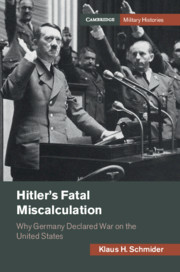Book contents
- Hitler’s Fatal Miscalculation
- Cambridge Military Histories
- Hitler’s Fatal Miscalculation
- Copyright page
- Epigraph
- Contents
- Figures
- Maps
- Preface
- Acknowledgements
- Abbreviations and German and Russian Terms
- Introduction
- 1 Hitler’s Pre-War Assessment of the United States and Japan
- 2 Hitler’s Physical Health in Autumn 1941
- 3 ‘All Measures Short of War’: the German Assessment of American Strategy, 1940–1941
- 4 Forging an Unlikely Alliance: Germany and Japan, 1933–1941
- 5 Facing the Same Dilemma: the US and German Quest for Rubber
- 6 The Crisis of the German War Economy, 1940–1941
- 7 The End of Blitzkrieg? Barbarossa and the Impact of Lend-Lease
- 8 The Battle of the Atlantic
- 9 The Luftwaffe on the Eve of Global War
- 10 The Holocaust
- Conclusion
- Bibliography
- Index
7 - The End of Blitzkrieg? Barbarossa and the Impact of Lend-Lease
Published online by Cambridge University Press: 08 January 2021
- Hitler’s Fatal Miscalculation
- Cambridge Military Histories
- Hitler’s Fatal Miscalculation
- Copyright page
- Epigraph
- Contents
- Figures
- Maps
- Preface
- Acknowledgements
- Abbreviations and German and Russian Terms
- Introduction
- 1 Hitler’s Pre-War Assessment of the United States and Japan
- 2 Hitler’s Physical Health in Autumn 1941
- 3 ‘All Measures Short of War’: the German Assessment of American Strategy, 1940–1941
- 4 Forging an Unlikely Alliance: Germany and Japan, 1933–1941
- 5 Facing the Same Dilemma: the US and German Quest for Rubber
- 6 The Crisis of the German War Economy, 1940–1941
- 7 The End of Blitzkrieg? Barbarossa and the Impact of Lend-Lease
- 8 The Battle of the Atlantic
- 9 The Luftwaffe on the Eve of Global War
- 10 The Holocaust
- Conclusion
- Bibliography
- Index
Summary
Conventional wisdom has it that on the day of Hitler’s declaration of war on the US, the Ostheer was reeling under the blows of a massive Soviet counteroffensive unleashed on December 5th, 1941 and which should have put paid to any notions of demobilising just a part of the army to free up labour for shipyards and the aeronautical industry. A closer examination of the primary sources, however, reveals that the Soviet counterstrike developed in such a gradual and haphazard fashion that a sense of alarm only began to develop in the days after December 13th and did not reach crisis point until December 18th. A number of different factors – to be discussed in detail in the chapter – favoured this dynamic.
Allied lend-Lease shipments to the USSR were carefully recorded, but not regarded as a threat because it was felt that the losses of the 1941 campaign season and the loss of the Donbass had crippled the regenerative powers of the Red Army to such an extent that a comeback was no longer feasible. Belated attempts to coordinate a global strategy with Japan in late December indicates that it was around this time that this estimate was reassessed.
Keywords
- Type
- Chapter
- Information
- Hitler's Fatal MiscalculationWhy Germany Declared War on the United States, pp. 321 - 426Publisher: Cambridge University PressPrint publication year: 2021

